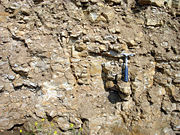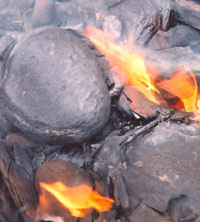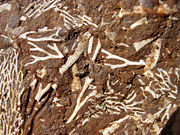Oil shale
2008/9 Schools Wikipedia Selection. Related subjects: Mineralogy
Oil shale is a fine-grained sedimentary rock which contains significant amounts of kerogen (a solid mixture of organic chemical compounds), from which technology can extract liquid hydrocarbons. Authorities have described the name oil shale as a promotional misnomer, since the rock does not necessarily consist of a shale and its kerogen differs from crude oil; it requires more processing than crude oil, which affects its economic viability as a crude-oil substitute and increases its environmental impact. Deposits of oil shale are located around the world, including major deposits in the United States of America. Global deposits are estimated as equivalent to 2.8 trillion to 3.3 trillion barrels (450×109 to 520×109 m3) of recoverable oil.
The chemical process of pyrolysis can convert the kerogen in oil shale into synthetic crude oil. Heating oil shale to a sufficiently high temperature will drive off a vapor which processing can distill (retort) to yield a petroleum-like shale oil—a form of non-conventional oil—and combustible shale gas ( shale gas can also refer to gas occurring naturally in shales). Oil shale can also be burned directly as a low-grade fuel for power generation and heating purposes and can be used as a raw material in the chemical and construction materials industries.
Oil shale has gained attention as an energy resource as the price of conventional sources of petroleum has risen and as a way for some areas to secure independence from external suppliers of energy. At the same time, oil shale mining and processing involve a number of environmental issues, such as land use, waste disposal, water use, waste-water management, greenhouse-gas emissions and air pollution. Estonia and China have well-established oil shale industries, and Brazil, Germany, Israel and Russia also utilize oil shale.
Geology

Oil shale consists of organic-rich sedimentary rock: it belongs to the group of sapropel fuels. It differs from bitumen-impregnated rocks ( tar sands and petroleum reservoir rocks), humic coals and carbonaceous shale. While tar sands originate from the biodegradation of oil, heat and pressure have not (yet) transformed the kerogen in oil shales into petroleum. Coal contains a higher percentage of organic matter than oil shale. In commercial grades of oil shale the ratio of organic matter to mineral matter lies approximately between 0.75:5 and 1.5:5. At the same time, the organic matter in oil shale has an atomic ratio of hydrogen to carbon approximately the same as for crude oil and about two to three times higher than for coals.
Oil shale does not have a definite geological definition nor a specific chemical formula. Oil shales vary considerably in their mineral content, chemical composition, age, type of kerogen, and depositional history. Oil shale seams do not always have discrete boundaries and the carbonaceous content varies. Scottish oil shales frequently exhibit a change from no carbonaceous content through a range of carbonaceous content and back to non-carbonaceous shales. As a rule of thumb, the better the oil shale, the more chocolaty-brown the streak and the more woody the sound when struck by a hammer.
The organic components of oil shale derive from a variety of organisms, such as the remains of algae, spores, pollen, plant cuticles and corky fragments of herbaceous and woody plants, and cellular debris from other aquatic and land plants. Some deposits contain significant fossils; Germany's Messel Pit has the status of a Unesco World Heritage Site. The mineral matter in oil shale includes various fine-grained silicates and carbonates.
Geologists can classify oil shales on the basis of their composition as carbonate-rich shales, siliceous shales, or cannel shales. Another classification, known as the van Krevelen diagram, assigns kerogen types, depending on the hydrogen, carbon, and oxygen content of oil shales' original organic matter. The most used classification of oil shales was developed between 1987 and 1991 by Adrian C. Hutton of the University of Wollongong, adapting petrographic terms from coal terminology. According to this classification, oil shales are designated as terrestrial, lacustrine (lake-bottom-deposited), or marine (ocean bottom-deposited), based on the environment where the initial biomass was deposited. Hutton's classification scheme has proven useful in estimating the yield and composition of the extracted oil.
Reserves
Some analysts, along with the United States Geological Survey (USGS), draw a distinction between oil-shale resources and oil-shale reserves. "Resources" may refer to all oil shale deposits, while "reserves", more narrowly defined, represent those deposits from which existing technologies can profitably extract oil. Since extraction technologies develop continuously, the amount of recoverable kerogen can only be estimated. Although oil shale resources occur in many countries, only 33 countries possess deposits of possible economic value. Well-explored deposits, potentially classifiable as reserves, include the Green River deposits in the western United States, the Tertiary deposits in Queensland, Australia, deposits in Sweden and Estonia, the El-Lajjun deposit in Jordan, and deposits in France, Germany, Brazil, China, southern Mongolia and Russia. It is expected that these deposits would yield at least 40 liters of shale oil per tonne of shale, using the Fischer assay.
A 2005 estimate set the total world resources of oil shale at 411 gigatons — enough to yield 2.8 to 3.3 trillion barrels (520 km³) of shale oil. This exceeds the world's proven conventional oil reserves, estimated at 1.317 trillion barrels (209.4×109 m3), as of 1 January 2007. The largest deposits in the world occur in the United States in the Green River basin, which covers portions of Colorado, Utah, and Wyoming; about 70% of this resource is located on federally owned or managed land. Deposits in the United States constitute 62% of world resources; together, the United States, Russia and Brazil account for 86% of the world's resources in terms of shale oil content. These figures are considered tentative, as several deposits have not yet been explored or analyzed.
History

Humans have used oil shale as a fuel since prehistoric times, since it generally burns without any processing. Britons of the Iron Age also used to polish it and form it into ornaments. Modern industrial oil-shale mining began in 1837 in Autun, France, followed by exploitation in Scotland, Germany, and several other countries. Operations during the 19th century focused on the production of kerosene, lamp oil, and paraffin; these products helped supply the growing demand for lighting that arose during the Industrial Revolution. Fuel oil, lubricating oil and grease, and ammonium sulfate were also produced. The oil shale industry expanded immediately before World War I because of limited access to conventional petroleum resources and the mass production of automobiles and trucks, which generated an increase in gasoline consumption.
Although the Estonian and Chinese oil-shale industries continued to grow after World War II, most other countries abandoned their projects due to high processing costs and the availability of cheaper petroleum. Following the 1973 oil crisis, world production of oil shale reached a peak of 46 million tonnes in 1980 before falling to about 16 million tonnes in 2000, due to competition from cheap conventional petroleum in the 1980s. On 2 May 1982, known as "Black Sunday", Exxon canceled its US$5 billion Colony Shale Oil Project near Parachute, Colorado, laying off more than 2,000 workers and leaving a trail of home-foreclosures and small-business bankruptcies. This led the United States Congress to abolish its Synthetic Liquid Fuels Program.
The global oil-shale industry began to revive in the mid-1990s. In 2003, an oil-shale development program restarted in the United States. Authorities introduced a commercial leasing program permitting the extraction of oil-shale and tar-sand resources on federal lands in 2005, in accordance with the Energy Policy Act of 2005.
Industry
As of 2008, industry uses oil shale in Brazil, China, Estonia and to some extent in Germany, Israel, and Russia. Several additional countries started assessing their reserves or had built experimental production plants, while others had phased out their oil shale industry. Oil shale serves for oil production in Estonia, Brazil, and China; for power generation in Estonia, China, Israel, and Germany; for cement production in Estonia, Germany, and China; and for use in chemical industries in China, Estonia, and Russia. As of 2005, Estonia alone accounted for about 70% of the world's oil shale production.
Romania and Russia have in the past run power-plants fired by oil shale, but have shut them down or switched to other fuel sources such as natural gas. Jordan and Egypt plan to construct power plants fired by oil shale, while Canada and Turkey plan to burn oil shale along with coal for power generation. Oil shale is used as the main fuel for power generation only in Estonia, where the oil shale-fired Narva Power Plants accounted for 95% of electrical generation in 2005.
Extraction and processing
Most exploitation of oil shale involves mining followed by shipping elsewhere, after which one can burn it directly to generate electricity, or undertake further processing. The most-often used methods of surface mining involve open pit mining and strip mining. These procedures remove most of the overlying material to expose the oil shale deposits, and are practical when the deposits are close to the surface. Underground mining of oil shale, which removes less of the overlying material, employs the room-and-pillar method.
The extraction of the useful components of oil shale usually takes place above ground (ex-situ processing), although several newer technologies perform this underground (on-site or in-situ processing). In either case, after accessing the shale, its kerogen is converted to synthetic crude oil and shale gas through the chemical process of pyrolysis. Most conversion technologies involve heating shale in the absence of oxygen to a temperature at which kerogen is decomposed (pyrolysed) into gas, condensable oil, and a solid residue; this usually takes place between 450 °C (842 °F) and 500 °C (932 °F). The process of decomposition begins at relatively low temperatures (300 °C/570 °F), but proceeds more rapidly and more completely at higher temperatures.
During the course of in-situ processing, mining-engineers heat the oil shale underground. These technologies can potentially extract more oil from a given area of land than ex-situ processes, since they can access the material at greater depths than do surface mines. Several companies have patented methods for in-situ retorting. However, most of these methods remain in the experimental phase. The methods are usually classified as true in-situ processes (TIS) and modified in-situ processes (MIS). True in-situ processes do not involve mining the oil shale. Modified in-situ processes drill a large shaft to transport workers and equipment to the shale formation, fracture the deposit and crush it, and ignite the rubble.
Hundreds of patents for oil-shale retorting technologies exist; however, only a few dozen have undergone testing. As of 2006, only four technologies were in commercial use: Kiviter, Galoter, Fushun, and Petrosix.
Applications and products
Industry can use oil shale as a fuel for thermal power plants, burning it (like coal) to drive steam turbines; some of these plants employ the resulting heat for district heating of homes and businesses. Sizable oil shale-fired power plants occur in Estonia, which has an installed capacity of 2,967 megawatts (MW), Israel (12.5 MW), China (12 MW), and Germany (9.9 MW).
In addition to its use as a fuel, oil shale may also serve in the production of specialty carbon fibers, adsorbent carbons, carbon black, phenols, resins, glues, tanning agents, mastic, road bitumen, cement, bricks, construction and decorative blocks, soil-additives, fertilizers, rock-wool insulation, glass, and pharmaceutical products. However, oil shale use for production of these items remains small or only in its experimental stages. Some oil shales yield sulfur, ammonia, alumina, soda ash, uranium, and nahcolite as shale-oil extraction byproducts. Between 1946 and 1952, a marine type of Dictyonema shale served for uranium production in Sillamäe, Estonia, and between 1950 and 1989 Sweden used alum shale for the same purposes. Another of its uses has been as a substitute for natural gas, but as of 2008, producing shale gas as a natural gas substitute is not economically feasible.
The oil derived from oil shale does not directly substitute for crude oil in all applications. It contains higher concentrations of olefins, oxygen, and nitrogen than conventional crude oil, as well as higher viscosities. By comparison with West Texas Intermediate, the benchmark standard for crude oil in the futures contract market, shale oil sulfur content ranges up to 9.5% by weight, where West Texas Intermediate's sulfur content has a maximum of 0.42%. The higher concentrations of these materials means that the oil must undergo considerable upgrading before serving as oil-refinery feedstock. Shale oil does not contain the full range of hydrocarbons used in modern gasoline production, and could only be used to produce middle-distillates such as kerosene, jet fuel, and diesel fuel. Worldwide demand for these middle distillates, however, has increased rapidly.
Economics
During the early 20th century, the crude-oil industry expanded. Since then, the various attempts to develop oil-shale deposits have succeeded only when the cost of shale-oil production in a given region come in below the price of crude oil or its other substitutes. According to a survey conducted by the RAND Corporation, the cost of producing a barrel of oil at a surface retorting complex in the United States (comprising a mine, retorting plant, upgrading plant, supporting utilities, and spent shale reclamation), would range between US$70–95 ($440–600/m3, adjusted to 2005 values). This estimate considers varying levels of kerogen quality and extraction efficiency. In order for the operation to be profitable, the price of crude oil would need to remain above these levels. The analysis also discusses the expectation that processing costs would drop after the complex was established. The hypothetical unit would see a cost reduction of 35–70% after its first 500 million barrels (79×106 m3) were produced. Assuming an increase in output of 25 thousand barrels per day (4.0×103 m3/d) during each year after the start of commercial production, the costs would then be expected to decline to $35–48 per barrel ($220–300/m3) within 12 years. After achieving the milestone of 1 billion barrels (160×106 m3), its costs would decline further to $30–40 per barrel ($190–250/m3). A comparison of the proposed US oil shale industry to the Alberta tar-sands industry has been drawn (the latter enterprise generated over one million barrels of oil per day in late 2007), stating that "the first-generation facility is the hardest, both technically and economically".
Royal Dutch Shell has announced that its in situ extraction technology in Colorado could become competitive at prices over $30 per barrel ($190/m3), while other technologies at full-scale production assert profitability at oil prices even lower than $20 per barrel ($130/m3). To increase the efficiency of oil-shale retorting, researchers have proposed and tested several co-pyrolysis processes.
Some commentators have compared shale-oil production unfavorably with other unconventional oil technologies, arguing that liquefaction of coal costs less money than oil-shale extraction, as well as producing more oil with fewer environmental impacts. In 1972, the journal Pétrole Informations (ISSN 0755-561X) noted that one ton of coal yielded 650 litres (170 U.S. gal/140 imp gal) of oil while one ton of oil shale yielded only 150 litres (40 U.S. gal/33 imp gal) of shale oil.
A critical measure of the viability of oil shale as an energy source lies in the ratio of the energy produced by the shale to the energy used in its mining and processing, a ratio known as "Energy Returned on Energy Invested" ( EROEI). A 1984 study estimated the EROEI of the various known oil shale deposits as varying between 0.7–13.3. Royal Dutch Shell has reported an EROEI of three to four on its in situ development, Mahogany Research Project. The water needed in the oil shale retorting process offers an additional economic consideration: this may pose a problem in areas with water scarcity.
Environmental considerations
Oil-shale mining involves a number of environmental impacts, more pronounced in surface mining than in underground mining. They include acid drainage induced by the sudden rapid exposure and subsequent oxidation of formerly buried materials, the introduction of metals into surface-water and groundwater, increased erosion, sulfur-gas emissions, and air pollution caused by the production of particulates during processing, transport, and support activities. In 2002, about 97% of air pollution, 86% of total waste and 23% of water pollution in Estonia came from the power industry, which uses oil shale as the main resource for its power production.
Oil-shale extraction can damage the biological and recreational value of land and the ecosystem in the mining area. Combustion and thermal processing generate waste material. In addition, the atmospheric emissions from oil shale processing and combustion include carbon dioxide, a greenhouse gas. Environmentalists oppose production and usage of oil shale, as it creates even more greenhouse gases than conventional fossil fuels. Section 526 of the Energy Independence And Security Act prohibits United States government agencies from buying oil produced by processes that produce more greenhouse gas emissions than would traditional petroleum. Experimental in situ conversion processes and carbon capture and storage technologies may reduce some of these concerns in the future, but at the same time they may cause other problems, including groundwater pollution.
Some commentators have expressed concerns over the oil-shale industry's use of water. In 2002, the oil-shale-fired power industry used 91% of the water consumed in Estonia. Depending on technology, above-ground retorting uses between one and five barrels of water per barrel of produced shale-oil. A 2007 programmatic environmental impact statement issued by the US Bureau of Land Management stated that surface mining and retort operations produce two to ten US gallons (1.5–8 imperial gallons or 8–38 L) of wastewater per tonne of processed oil shale. In situ processing, according to one estimate, uses about one-tenth as much water. Water concerns become particularly sensitive issues in arid regions, such as the western US and Israel's Negev Desert, where there are plans to expand the oil shale industry despite a water shortage.
Environmental activists, including members of Greenpeace, have organized strong protests against the oil-shale industry. In one result, Queensland Energy Resources put the proposed Stuart Oil Shale Project in Australia on hold in 2004.



